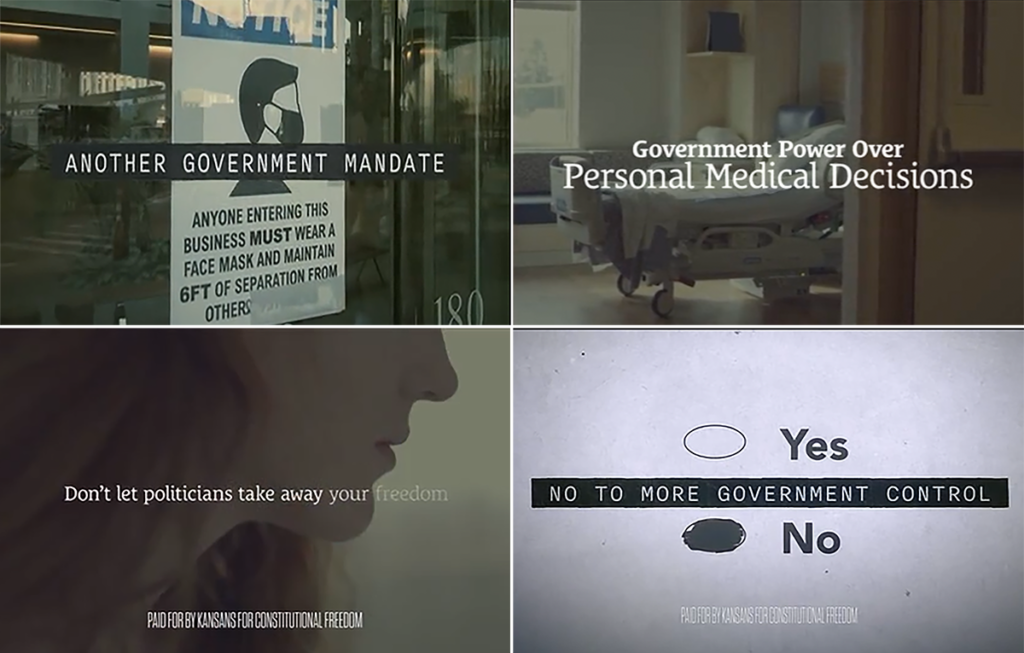2022 Campaign Advertising Highlights: References to Abortion in Ads Reveals Anti-Government Messaging on Both Sides
Such a strategy has broader implications for public health
In the wake of the Dobbs Supreme Court decision overturning Roe v. Wade abortion rights, messaging in political campaign ads for the 2022 midterm elections has featured abortion prominently, especially in pro-Democratic messaging.
In their recent release covering early September, the Wesleyan Media Project (WMP) reports that abortion is discussed in 50 percent of pro-Democratic gubernatorial ads, 26 percent of pro-Democratic U.S. House ads, and 23 percent of pro-Democratic U.S. Senate television advertising. Although discussion of abortion varies state-by-state (see here for the proportion of federal advertising from August 2022 and from September 2022), Kansas was the first state in 2022 to have voters weigh in on abortion rights through a ballot initiative on their August 2 primary election ballot. Not surprisingly, As a result, Kansans saw a large number of television ads (12,831 over six weeks) for and against the measure to alter the state constitution in order to give the legislature the authority to pass an abortion ban.
Much of the messaging in Kansas advertising featured traditional abortion arguments including concern over late-term or ‘painful dismemberment’ abortions from the pro-life (and pro-amendment) side and concern for the life and safety of the mother and the lack of exceptions for cases of rape and incest from the pro-abortion rights (and anti-amendment) opposition (for a quantitative breakdown of the content of messaging, see this WMP table). However, a non-trivial portion of advertising on both sides also included anti-government messaging.
Nearly half of advertising in favor of the amendment attempted to make a link between the opposition and the “radical left” or Democratic leaders (typically Biden but Pelosi was also featured), and one ad even stated that “Joe Biden and liberal justices are pushing to mandate abortion in Kansas with no restrictions” (see Figure 1).

Perhaps more surprising, a large number of the ads run by Kansans for Constitutional Freedom (the core organization taking a pro-choice and anti-constitutional amendment stance) also featured anti-government messaging, including some that may undermine public health authority. More specifically, many of the ads compared the proposed constitutional amendment to undesirable government overreach and government mandates. One ad even went so far as to say that “Kansans don’t want another government mandate” while printing the words “another government mandate” over an image of a sign requiring masks on the front door of a business establishment (see Figure 2).

Similar to past work where we have analyzed the messengers in federally-affiliated public service announcements and in local television coverage of paid family leave, we also took a look at who was featured as spokespeople in the ads. Although many ads simply used narration through voiceovers, when individuals appeared in the ads from either side, they were frequently women. Medical professionals (doctors or nurses identifiable through their lab coat or scrubs) appeared in advertising on both sides, but made up a greater percentage of the pro-life/pro-amendment advertising.
Advertising on both sides was likely intended to appeal to persuadable voters on the issue of abortion rights. Pro-abortion rights advocates (particularly in conservative-leaning states) who oppose the amendment likely needed to convince some conservative-leaning voters and chose anti-governmental messaging as a way to win support for opposing the measure. In the short-term, this strategy seems intuitive. However, it is possible that the short-term gain from such messaging may further erode trust in public health authority by priming viewers to think of the government’s role in protecting the public’s health (such as through mask requirements) in a negative light. With levels of mistrust in both government and public health experts on the rise, it’s important to consider potential unintended consequences of political messaging from one policy domain to another when taking a broad view of the many factors that together promote population health.
______
The COMM team includes members of the Wesleyan Media Project (WMP). Since the 2010 election cycle, WMP has been providing real-time information on the extent of corporate and union spending in federal election campaigns across the country, who specifically is doing that spending and which candidates are benefiting. In the Fall of 2022, the COMM team will be providing periodic commentaries about the ways in which discourse in political ads is relevant to health equity.
This post was funded by the Robert Wood Johnson Foundation (Grant no. 79754). The views expressed here do not necessarily reflect the views of the foundation.